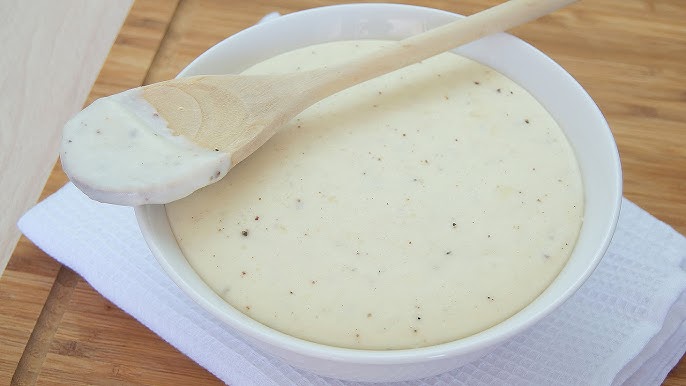White Sauce Recipe: White sauce, also known as Béchamel sauce, is a versatile and creamy base used in various dishes. Originating from French cuisine, this simple sauce consists of a roux (butter and flour) combined with milk to create a smooth, silky texture. It’s the backbone of numerous recipes, from classic pasta dishes to casseroles and gratins.
Common Uses of White Sauce
White sauce is incredibly adaptable, making it a staple in many kitchens. Use it as:
- A base for cheesy sauces in lasagna or macaroni and cheese.
- A topping for baked vegetables.
- A complement to meat or fish dishes.
- A binder for casseroles.
Ingredients for White Sauce
Essential Ingredients
To make a basic white sauce, you’ll need:
- Butter: 2 tablespoons (unsalted for better control of salt).
- All-Purpose Flour: 2 tablespoons for thickening.
- Milk: 2 cups (preferably whole milk for creaminess).
- Salt and Pepper: To season.
Optional Add-ons for Flavor
Enhance the flavor with:
- Grated Cheese: For a cheesy variation.
- Garlic Powder or Fresh Garlic: To add depth.
- Herbs: Such as thyme, parsley, or basil.
- Nutmeg: A pinch for a traditional French touch.
Tools You’ll Need
Cooking Tools
- A medium-sized saucepan.
- A whisk (essential for lump-free mixing).
- A wooden spoon or spatula for stirring.
Measuring Equipment
- Measuring cups for milk.
- Measuring spoons for butter and flour.
How to Make White Sauce
Step 1: Preparing the Ingredients
Measure and organize all the ingredients beforehand. This ensures a smooth cooking process without interruptions.
Step 2: Melting the Butter
Place your saucepan over medium heat. Add the butter and let it melt completely, ensuring it doesn’t brown.
Step 3: Adding the Flour
Once the butter has melted, sprinkle in the flour. Whisk continuously for 1–2 minutes to cook the flour and eliminate any raw taste. The mixture should form a smooth paste called a roux.
Step 4: Gradually Adding Milk
Slowly pour in the milk, whisking constantly to prevent lumps. Add it in small increments, allowing the mixture to thicken before adding more.
Step 5: Achieving the Right Consistency
Continue whisking until the sauce reaches your desired consistency. For a thicker sauce, cook it longer. For a thinner sauce, add more milk gradually.
Tips for Perfect White Sauce Every Time
Avoiding Lumps
- Always whisk continuously, especially when adding milk.
- Ensure the milk is at room temperature for smoother blending.
Adjusting Consistency to Your Dish
- Add more milk if you need a thinner sauce for soups.
- For a thicker sauce, increase the flour and butter slightly.
Variations of White Sauce
Cheese Sauce
Turn your basic white sauce into a rich and creamy cheese sauce by stirring in 1 to 2 cups of grated cheese after the sauce thickens. Cheddar, Parmesan, or Gruyère are excellent choices. Let the cheese melt completely while whisking to ensure smoothness. This variation is perfect for macaroni and cheese or as a dip for nachos.
Garlic-Infused Sauce
For a flavorful twist, sauté minced garlic in the butter before adding the flour. This creates a fragrant base ideal for pasta dishes like Alfredo or as a topping for baked potatoes.
Herb-Infused White Sauce
Add fresh or dried herbs such as thyme, oregano, or parsley while the sauce simmers. This infusion pairs beautifully with roasted vegetables, chicken, or fish dishes.
Common Mistakes and How to Fix Them
Sauce Too Thick or Too Thin
- If your sauce becomes too thick, gradually whisk in more milk until you achieve the desired consistency.
- For a sauce that’s too thin, mix a small amount of flour with melted butter to create a paste and whisk it into the sauce. Allow it to cook for a few minutes to thicken.
Burnt Butter or Flour
If the butter or roux burns, it’s best to start over. Burnt roux will affect the taste of the sauce, making it bitter and unappealing. Always cook over medium heat and stir continuously.
Serving Ideas for White Sauce
Pasta Dishes
White sauce is a go-to for creamy pasta recipes. Use it as the base for Alfredo sauce or in baked ziti for a luscious, velvety texture.
Vegetable Side Dishes
Pour white sauce over steamed or roasted vegetables like broccoli, cauliflower, or carrots for an indulgent side dish.
Meat and Fish Pairings
Use white sauce as a topping for grilled chicken or baked salmon. Its mild flavor complements a variety of proteins without overpowering their natural taste.
Storing and Reheating White Sauce
Refrigeration Guidelines
Store leftover white sauce in an airtight container in the refrigerator for up to 3 days. Ensure the sauce cools to room temperature before sealing to prevent condensation.
Reheating Tips
Reheat the sauce over low heat, stirring continuously. Add a splash of milk to restore its creamy consistency if it has thickened during storage.
Nutritional Information of White Sauce
Calorie Content
A basic white sauce made with whole milk and butter typically contains about 100 calories per ¼ cup serving. However, this can vary depending on the type of milk and any added ingredients like cheese or cream.
Adjusting for Dietary Needs
- For a lower-calorie version, use skim milk and reduce the butter.
- For gluten-free white sauce, substitute all-purpose flour with gluten-free flour or cornstarch.
FAQs about White Sauce Recipe
Can You Make White Sauce in Advance?
Yes, you can prepare white sauce in advance and store it in the refrigerator for up to 3 days. Reheat it gently, adding a splash of milk to maintain its texture.
Can White Sauce Be Frozen?
While freezing is possible, the texture may change slightly upon thawing. To minimize separation, reheat slowly and whisk vigorously.
How Can I Make It Gluten-Free?
Substitute all-purpose flour with gluten-free flour or cornstarch. Ensure you follow the same steps for making the roux and whisk thoroughly for a smooth texture.
What’s the Best Milk for White Sauce?
Whole milk is ideal for a rich and creamy sauce, but you can use 2%, skim, or even non-dairy alternatives like almond or oat milk for different dietary needs.
How to Add Flavor to White Sauce Without Overpowering It?
Subtle additions like a pinch of nutmeg, a splash of white wine, or a sprinkle of Parmesan cheese can enhance the flavor without making it too bold.
Conclusion
White sauce is a timeless recipe that every home cook should master. Its simplicity and versatility make it a cornerstone of countless dishes, from comforting casseroles to elegant pasta dishes. With the step-by-step guide provided, you’re well on your way to creating the perfect white sauce that suits your taste and culinary needs.



